Abstract
Bamboo is widely distributed throughout the world, particularly in tropical and subtropical regions. This study aims to investigate the biomechanical properties of the root system of Bambusa pachinensis (Pachi bamboo). The root system of Pachi bamboo grows densely in clusters, with most roots growing vertically and potentially penetrating more than one meter into the soil after growing for several years. Owing to these characteristics, Pachi bamboo is considered a promising plant species for soil reinforcement. However, research on its root reinforcement capabilities remains limited. In situ shear and pullout tests were conducted to assess the root reinforcement of the fibrous root system. The root diameters of Pachi bamboo are typically less than 4 mm, and its tensile strength is notably lower than that of tree roots. This study establishes a method for estimating the root reinforcement of Pachi bamboo based on the number and cross-sectional area of the culms in a single bamboo cluster. The relationship between the maximum tensile force (Fult) and root diameter (D) is Fult = (3.65)D2.59, where Fult is in Newtons (N), and D is in millimeters (mm). The relationship between the pullout resistance (Pult) and the shear resistance (Sult) with the number of culms (SN) is Pult = 46.5(SN) and Sult = 0.53(SN) + 5, where Pult is in Newtons (N), and Sult is in kilopascals (kPa). These results suggest a positive contribution of the number of culms to mechanical resistance.
1. Introduction
Plant species and root morphology are crucial factors in a plant’s ability to reinforce the soil. The complex and diverse root system morphologies of different plant species have been a focal point of research in recent decades, reflecting the collaborative efforts of the scientific community. This collective work has led to the development of methods for estimating the shear resistance provided by roots in the soil, based on simplified root reinforcement models [1,2,3] and field experiments on rooted soils [4,5]. Another key factor influencing the reinforcement effect of a plant root system is the soil–root bonding strength, which directly affects the pullout resistance of the root system in soil [6,7]. Additionally, the contribution of plant root systems to slope stability has been extensively analyzed and discussed by researchers, further emphasizing the collaborative nature of this field [8,9,10,11,12,13].
Tap and oblique roots in a root system are considered advantageous for enhancing soil resistance [5,14]. Dense, thin roots offer good tensile resistance, while long tap roots provide bending resistance within the soil [15,16]. Stokes et al. (2009) [16] also suggested that dense, thin roots offer better resistance to soil than fewer, thicker roots, even when the root area ratios (RARs) are identical. Previous analytical studies have indicated that the critical root length required for effective root anchorage in the soil increases with root diameter [17]. Planting root systems with favorable characteristics on slopes is essential for providing better reinforcement and stability in soil bioengineering techniques [18].
Root forces generated in root-permeated soils subjected to deformation are crucial for mobilizing the resistance provided by root systems in the soil. The mechanical properties of plant roots are essential parameters for evaluating root reinforcement in the soil. Root systems vary significantly across plant species. Bamboo, for instance, is a species with many thin roots. Studies have shown that bamboo root systems can improve soil erosion control and conservation [19,20,21,22]. Furthermore, bamboo root systems act as anchors for the soil, preventing shallow landslips in forest slopelands [19,23]. The mechanical properties of bamboo fibers have been extensively studied over the past decades [24,25,26,27,28]. Additionally, research on the mechanical performance of bamboo fiber-reinforced composites has been conducted under various treatments and conditions [27,29,30,31]. However, there has been limited research on the quantitative contribution of bamboo roots to reinforcement in the soil.
Bamboo is widely distributed worldwide [32]. It is used in soil bioengineering techniques, and it has an effective ability to reduce soil detachment and movement. Bamboos generally grow faster than other forest plant species and thrive in various soil conditions, including sandy, loamy, lateritic, and alluvial soils [32]. Bamboo root systems are classified into two types: clumping and running. Clumping bamboos have culms that grow close together, whereas running bamboos feature a horizontal root system (rhizome) that spreads widely from the shoot. Bambusa pachinensis (Pachi bamboo), a clumping species first reported in Taiwan in 1916 [33], is characterized by a dense and thin root system. This bamboo species has also been identified in Southeastern China [34].
The root distribution of Pachi bamboo is a fibrous root system, characterized by a dense network of fine roots and the absence of a distinct taproot. Fibrous root systems generally exhibit relatively shallow rooting depths compared to those of woody species [35,36]. Despite this shallowness, they contribute to soil strength at a different scale, primarily through the combined effects of root depth and biomass [36]. Moreover, specific root traits—such as the presence of root hairs and the distribution of root diameters—can significantly influence shear strength by altering failure mechanisms within the soil–root matrix [36].
Roots that intersect a potential sliding surface enhance the soil’s shear resistance through a mechanism known as basal root reinforcement [37,38]. This process is most effective when the rooting depth extends beyond the depth of the sliding surface [37]. The root system of Pachi bamboo is clumping in nature, consisting of numerous fine roots along with long, slender roots. With a rooting depth reaching the meter scale, Pachi bamboo has the potential to contribute meaningfully to basal root reinforcement in shallow slope failures, while also playing a vital role in controlling surface soil erosion. To assess the contribution of Pachi bamboo root systems to root reinforcement, it is essential to understand the mechanical properties of these roots.
Pullout resistance and shear resistance represent the capacities of root systems to withstand different types of applied forces [39]. The tensile strength of individual roots contributes to the mobilization of both pullout and shear resistance within the root system. It is important to recognize that pullout resistance, shear resistance, and tensile strength of individual roots each serve distinct but complementary functions in the overall root reinforcement mechanism. This research aims to investigate the mechanical properties of the Pachi bamboo root system. By performing in situ shear, pullout, and tensile tests on Pachi bamboo roots, we aim to establish a correlation between the root reinforcement of the bamboo root system and the characteristics of the bamboo. It is assumed that the root reinforcement of Pachi bamboo systems is correlated with the characteristics of bamboo culms. The findings of this study can be applied to assess the stability of sloping lands or riverbanks planted with Pachi bamboo, thereby enhancing the practicality and relevance of our research and offering valuable insights for engineering and environmental conservation practices.
2. Materials and Methods
2.1. Test Site
The test site, located on the west campus of Kaohsiung University of Science and Technology in Kaohsiung, Taiwan, is covered with sparse grass, Axonopus affinis. There were also small amounts of other grass species at the test site.
The soil at the site had a unit weight ranging from 14.9 to 15.8 kN/m3 and a dry unit weight between 12.2 and 13.1 kN/m3. According to the Unified Soil Classification System (USCS), the soil is classified as SP (poorly graded sand). These soil conditions provided an ideal environment for conducting the in situ tests on the Pachi bamboo root system.
2.2. Pachi Bamboo
Pachi bamboo culms are slender and grow in close clusters, with heights reaching between 3 and 8 m. Field investigations revealed that the root system of Pachi bamboo is dense and classified as clumping bamboo. Most of the roots grow vertically, penetrating deeply into the soil, while the lateral roots at shallower depths remain short. At other sites, Pachi bamboo roots extended to at least 1.6 m in length after four years of growth, as illustrated in Figure 1. Several roots, visible in the lower center of the image, were exposed within an excavated trench. A person holding a tape measure is shown in the photo to provide a scale reference for the exposed rooting depths.
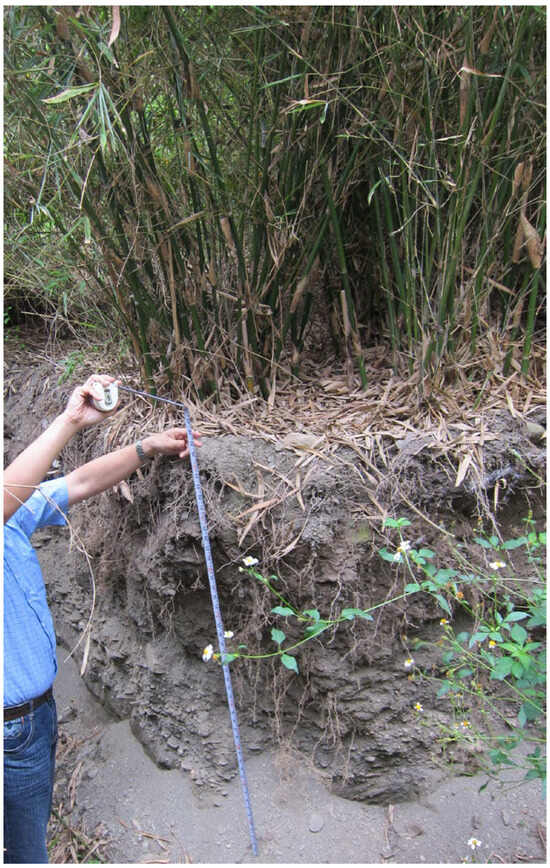
Figure 1.
Depth of the Pachi bamboo root system after growing for four years.
The Pachi bamboo at the test site had grown for two years. After the in situ shear test, we measured the root characteristics of Pachi bamboo. A small shovel was used to carefully excavate the soil around the entire root system until it was fully exposed. The investigation of the below-ground root system can be challenging and time-consuming, and roots may break during excavation [40]. The length, diameter, and orientation of each root in the Pachi bamboo root system were recorded. Root orientation (θ) was measured as the departure angle relative to the shear direction, ranging from 0° to 180°. Root diameters were measured using digital calipers with a resolution of 0.01 mm.
2.3. Mechanical Tests on Bamboo Root Systems and Testing Apparatus
The roots of Pachi bamboo exhibit a fibrous structure. In situ shear tests are well-suited for evaluating the reinforcement of these roots when subjected to shear forces at specific depths [39]. In situ shear tests were performed on soil samples permeated by the Pachi bamboo root system. The shear box used had a width of 0.6 m and a thickness of 0.5 m, with a shearing rate of 0.01 m/min. A test pit was excavated around the Pachi bamboo to match the dimensions of the shear box. The shear box and its components were designed for easy assembly in the field. A turbine wheel hoisting jack was employed to apply shear force to the back side of the shear box. Shear displacement and pushing force were measured using extensometers and load cells, with data recorded using a data logging system. The shear plane was located at a depth of 0.3 m. A total of 5 in situ shear tests were conducted on Pachi bamboo clusters in this study. Moreover, shear tests for five bare soil specimens were also carried out. A photo of the in situ shear test is shown in Figure 2a.
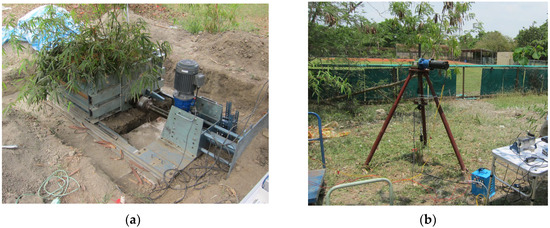
Figure 2.
The apparatus of in situ mechanical tests. (a) In situ shear test; (b) in situ pullout test.
Due to the fibrous nature of the Pachi bamboo root system, conducting pullout tests on single roots is largely impractical. Therefore, testing the entire root system under external forces near the ground surface is a more effective approach for assessing its anchorage performance. With many culms above ground and the roots deeply entwined in the soil, it is more practical to evaluate the pullout resistance of Pachi bamboo based on the bamboo culms themselves. In this study, we conducted pullout tests on five bamboo cluster samples, each with varying numbers of culms. The pullout test apparatus used a motor to apply the pulling force at a rate of 0.01 m/min. A steel wire was used to apply the pulling force to the root system beneath the bamboo shoots, and the pulling force could be applied vertically. A total of five pullout tests were performed on the Pachi bamboo clusters in this study. The soil moisture content for each specimen was measured after the experiments. A photo of the in situ pullout test is shown in Figure 2b.
Tensile tests on individual roots serve as the fundamental method for determining their tensile properties. In addition, the tensile properties of plant roots are crucial for providing shear resistance in the soil [1,41]. In this study, thirty-seven tensile tests were conducted on individual roots with uniform diameters ranging from 0.6 mm to 2.7 mm. These roots were collected from various bamboo root systems, and the root diameter near the rupture location was measured. The relationship between root diameter and the tensile strength of individual bamboo roots was established using the power function [42].
3. Results
3.1. Geometric Characteristics of Pachi Bamboo Root Systems
Figure 3 illustrates the root system of a Pachi bamboo cluster, characterized by numerous near-vertical roots and short lateral roots. The longest root in the 2.2-year-old bamboo cluster measured approximately 0.65 m, while the lateral roots were abundant and concentrated in the top 0.15 m of the soil. Most root diameters were less than 4 mm, with the majority ranging between 1.5 and 2 mm. Figure 4 presents the statistical distribution of number of roots and cross-sectional areas in various orientations within the root system based on 5 root system specimens after the pullout tests. Around 42% of the roots were near-vertical, positioned at angles between 70° and 110° relative to the horizontal plane. Notably, near-vertical roots accounted for approximately 45% of the total cross-sectional root area in the root system. The roots of Pachi bamboo are thin—typically less than 3–4 mm in diameter—and highly flexible. When subjected to shear or pullout forces, these roots may adjust their orientation within the soil matrix. Due to their slender and pliable nature, Pachi bamboo roots are well-suited to mobilize tensile forces in response to external loading, enhancing their contribution to soil reinforcement.
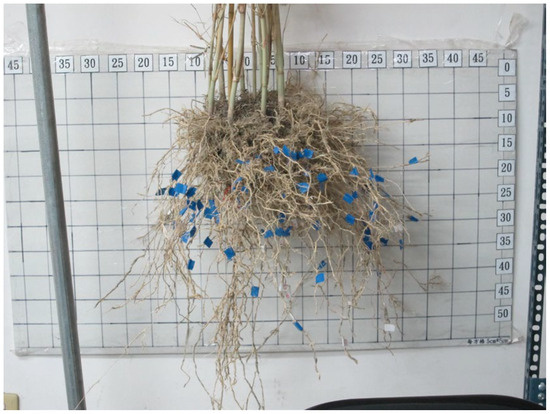
Figure 3.
The Pachi bamboo root system at the test site (the numerals shown in the figures are in units of centimeters; the blue tag in the photo is used to facilitate the counting of roots with different diameters).
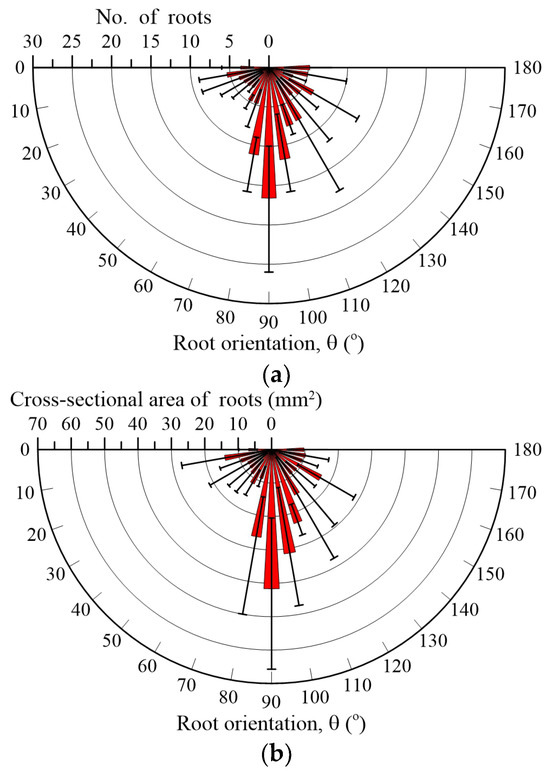
Figure 4.
The geometrical distribution of the Pachi bamboo root system. (a) Number of roots vs. root orientation; (b) cross-sectional area vs. root orientation (the black line at the end of the red line represents the error bar).
3.2. Tensile Properties of Pachi Bamboo Roots
Potential errors may arise in the measurement of root diameter [43]. It is preferable to present the mechanical properties of roots in terms of force instead of stress [43]. Figure 5a illustrates the relationship between the maximum tensile force (Fult) and the diameter (D) of Pachi bamboo roots. The elongation strain at the maximum tensile force varied between 10% and 17%. The relationship between the maximum tensile force (Fult) and root diameter (D) is expressed mathematically as
where Fult is in N, and D is in mm.
Fult = (3.65)D2.59 R2 = 0.48

Figure 5.
Tensile properties of Pachi bamboo roots. (a) Maximum tensile force; (b) elastic modulus.
In addition, Figure 5b presents the relationship between elastic modulus (E) of Pachi bamboo roots and their diameter (D). This relationship is described by the following equation:
where E is in MPa.
E = (800.5)D−1.56 R2 = 0.39
3.3. Pullout Resistance of Pachi Bamboo Root Systems in Soil
Figure 6 illustrates the relationship between pullout force and pullout displacement for Pachi bamboo root systems for five specimens. Table 1 summarizes the pullout test results and the root system characteristics of the five bamboo cluster samples. The maximum pullout forces for bamboo roots with varying numbers of culms ranged from 285 N to 1061 N, and the shear displacements occurred at about 56 mm to 95 mm. Among the five Pachi bamboo cluster samples, 45%–59% of the roots were near-vertical.
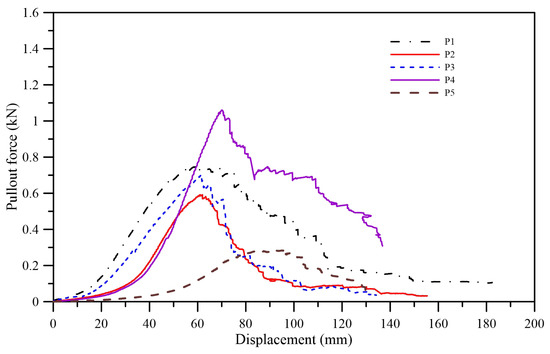
Figure 6.
Pullout force vs. pullout displacement of the Pachi bamboo root system.

Table 1.
Pullout test results on the root system of Pachi bamboo.
3.4. Shear Resistance of Pachi Bamboo Root Systems in Soils
Figure 7 depicts the relationship between shear stress and shear displacement for five shear tests on Pachi bamboo root systems. The soil moisture contents for specimen S1R, S2R, S3R, S4R, and S5R are 6%, 23.7%, 35.2%, 31.3%, and 32.5%, respectively. Table 2 summarizes the shear test results alongside the root system characteristics of the five bamboo clusters. The soil moisture content for S1R specimen is considerably low compared with other specimens, and its maximum shear stress reached 47.5 kPa. The S1R data will be excluded from the following study on the correlation between the shear resistance and the quantity of bamboo clusters and the root system.

Figure 7.
Shear stress vs. shear displacement of the soil permeated with Pachi bamboo root system.

Table 2.
In situ shear test results of the Pachi bamboo root system.
In addition, we carried out four shear tests for bare soil specimens. The soil moisture contents for these specimens were 7.5% 9.1%, 33.4%, and 33.3%, and their shear strengths were 27.5 kPa, 17.8 kPa, 10.32 kPa, and 10.45 kPa, respectively. The soil moisture content considerably affects the shear strength of the soil. The soil moisture contents for the shear tests on bamboo root soil specimens were in the range of 23~35%. Thus, the shear strength of the bare soil with a soil moisture content of 33.3% can be used as a reference shear strength for rooted soil.
3.5. Relationships Between the Characteristics of Pachi Bamboo and Root Reinforcement
3.5.1. Pullout Resistance of Pachi Bamboo Roots
Several factors, including the number of roots, root geometry, the spatial distribution of the root system, and soil properties, influence the pullout resistance of plant roots. Pachi bamboos typically grow in clusters of culms with dense root systems. Accurately estimating the number of roots in a single bamboo is challenging; however, the number of culms, which are typically uniform in diameter, can be easily identified in the field. In this study, the culm diameters of Pachi bamboo ranged from 7.5 mm to 8.7 mm. This research aimed to establish a correlation between the pullout resistance of bamboo root systems and the number of bamboo culms.
Figure 8 illustrates the relationship between the maximum pullout force (Pult) of Pachi bamboo root systems and the number of culms. The results indicate that the maximum pullout force (Pult) increases with the number of culms. However, one test result (test P4 in Table 1) showed significantly higher pullout resistance compared to the other data points, and the number of culms of the P4 specimen was 9. This unusually high pullout resistance may be attributed to the lower soil water content in the corresponding soil specimen. To enhance the reliability of the regression analysis, the data from Test P4 were excluded. The equation representing the fitted relationship in Figure 8 is as follows:
where Pult is the maximum pullout force (N), and SN represents the number of bamboo culms in a single bamboo cluster. Additionally, Figure 9 demonstrates the positive relationship between the maximum pullout force of the Pachi bamboo root system and the total cross-sectional area of the culms in a cluster. The mathematical equation that fits the data in Figure 9 is as follows:
where SA is the total cross-sectional area (mm2) of culms in a Pachi bamboo cluster.
Pult = 46.5(SN) R2 = 0.56
Pult = 0.75(SA) + 100 R2 = 0.25

Figure 8.
Maximum pullout force vs. number of bamboo culms in a bamboo cluster.
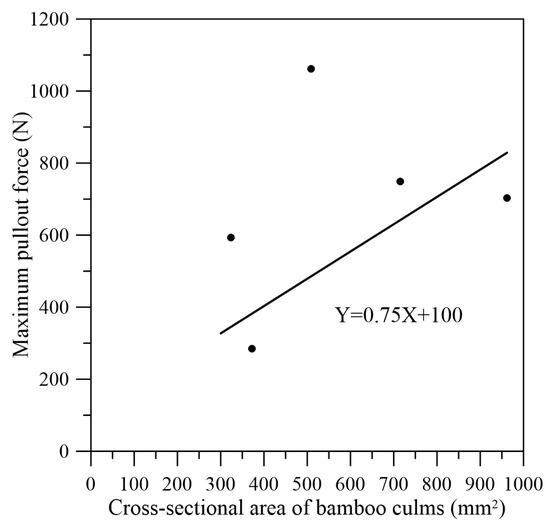
Figure 9.
Maximum pullout force vs. cross-sectional area of bamboo culms in a bamboo cluster.
3.5.2. Shear Resistance of Soils Permeated with Pachi Bamboo Root System
Similar to the pullout resistance of bamboo roots discussed earlier, the number of bamboo culms and their cross-sectional area can also be used to characterize the shear resistance of bamboo root systems in soil. Figure 10 illustrates the relationship between the maximum shear resistance of the Pachi bamboo root system and the number of culms. The results show that the maximum shear resistance increases with the number of culms. However, one test result (test S1R in Table 2) exhibited significantly higher shear resistance compared to the other data points due to a low soil water content. The data from test S1R were excluded to refine the regression. The equation describing the fitted relationship between maximum shear resistance and the number of culms is as follows:
where Sult (kPa) represents the maximum shear resistance. Additionally, Figure 11 shows the relationship between the maximum shear stress of the Pachi bamboo root system and the cross-sectional area (SA) of the culms in a cluster. The mathematical equation for fitting Sult (kPa) and SA (mm2) is as follows:
Sult = 0.53(SN) + 5 R2 = 0.17
Sult = 0.01(SA) + 1.5 R2 = 0.26
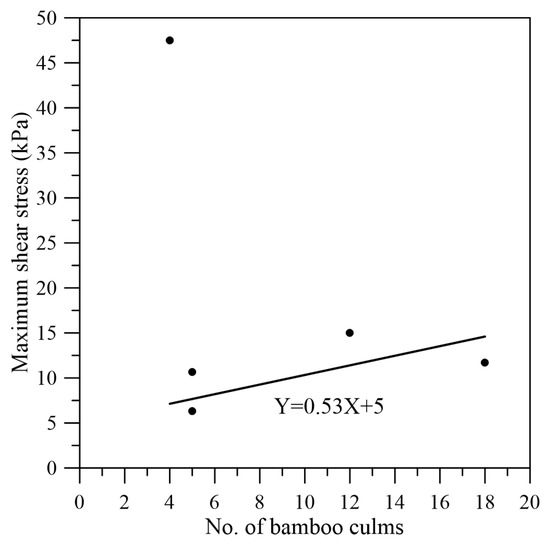
Figure 10.
Maximum shear stress vs. number of bamboo culms in a bamboo cluster.
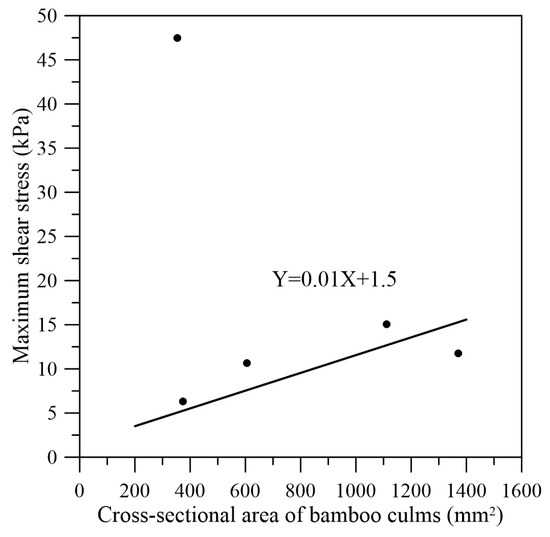
Figure 11.
Maximum shear stress vs. cross-sectional area of bamboo culms in a bamboo cluster.
The characteristics of bamboo culms, such as the number of culms and cross-sectional area, can be easily determined in the field. Using the equations developed in this study, the shear resistance of soils with a Pachi bamboo cluster can be effectively estimated.
4. Discussion
4.1. Pachi Bamboo Root System Distribution
Monocot plant species, which are characterized by fibrous root systems—such as grass, rice, maize, corn, barley, millet, and bamboo—typically develop lateral roots concentrated in the topsoil [44]. As a result, their root reinforcement is confined mainly to very shallow depths. In contrast, the Pachi bamboo exhibits a deep-rooting system, with roots extending to depths on the order of meters. Consequently, the root reinforcement provided by the Pachi bamboo is considered significantly deeper than that of the aforementioned species.
The Pachi bamboo root system grows in clumps, forming a dense network of thin roots within each cluster. The bamboo roots intertwine intricately with the surrounding soil, creating cohesive soil–root blocks that serve as natural reinforcements, enhancing the soil’s structural stability. This unique root system plays a significant role in preventing soil displacement and mitigating erosion. Researchers have highlighted the importance of bamboo roots in soil stabilization and erosion control due to their distinctive characteristics and adaptability to various environments [19,20]. Zhou et al. (2005) [19] noted that bamboo is equipped with an extensive fibrous root system that integrates seamlessly with its rhizomes. This root–rhizome network not only binds the soil but also effectively protects shallow layers of soil from erosion caused by water and wind forces [19]. The combination of its clumping growth pattern and fibrous root structure, shown in Figure 3, makes Pachi bamboo particularly valuable for soil bioengineering techniques, including slope stabilization, riverbank reinforcement, and degraded land rehabilitation.
The Pachi bamboo root system penetrates deeply into the soil, demonstrating its capacity for soil anchorage and nutrient acquisition. Field observations, shown in Figure 1, showed that the roots of Pachi bamboo extended to depths exceeding 1.6 m within just four years of growth, highlighting its rapid development. Each bamboo cluster, composed of 7–18 culms, contains over 100 thin roots, which together form a dense and complex root network. This dense rooting system differs significantly from that of broadleaf and conifer trees, as the Pachi bamboo’s root distribution is highly specialized. Approximately 45–55% of the roots within a cluster grow in a near-vertical orientation, allowing them to penetrate deeply and anchor the plant securely in the soil. Additionally, investigations of 2.2-year-old bamboo root systems revealed that a large number of roots grow in a single cluster and are exceptionally fine, with diameters of less than 4 mm. This fine root structure facilitates effective soil penetration and enhances soil–root cohesion, making it a favorable candidate for applications in erosion control and slope stabilization. The findings of this study provide quantitative insights into the geometric and functional characteristics of the Pachi bamboo root system, offering valuable data for both ecological and engineering applications.
4.2. Tensile Property and Root Reinforcement
The root properties of bamboo have historically received limited attention, particularly concerning the performance of bamboo root systems in soil reinforcement. Few studies have explored the root reinforcement of natural bamboo root systems in detail. For instance, Ma’ruf (2012) [45] conducted laboratory shear tests on soil samples permeated with Apus bamboo roots, finding that the increase in soil shear strength was positively correlated with the soil-root volume ratio. Remarkably, soil reinforced with Apus bamboo roots exhibited a shear strength increase of up to 55% of the peak soil shear strength, even when the soil-root volume ratio was as low as 5%. Additionally, Mulyanti et al. (2024) [46] reported that the tensile strength of bamboo roots ranged between 23 MPa and 45 MPa, while their water content was approximately 85%–90%. Beyond soil reinforcement, bamboo root fibers have also been utilized as reinforcements in composite materials by combining bamboo roots with resins and catalysts [46].
The maximum tensile force of Pachi bamboo roots varies with root diameter, ranging from 10 N to 60 N for root diameters between 1 mm and 3 mm. Figure 12 illustrates the relationship between the maximum tensile force and root diameter for Pachi bamboo and other fibrous root species, including maize, vetiver, ruzi grass, Italian ryegrass, perennial ryegrass, and tall fescue. The results show that the maximum tensile force of Pachi bamboo roots is generally slightly higher than that of the grass species and is comparable to that of vetiver. Notably, several data points for Pachi bamboo exhibit higher tensile forces than those of the other species.
In addition, the relationship of the elastic modulus vs. root diameter of tree roots showed more intraspecific differences compared to the interspecific ones [47]. The elastic modulus of Pachi bamboo roots is 800, 271, and 144 MPa at the root diameter of 1, 2, and 3 mm, respectively. A study by Cislaghi (2021) [47] focused on tree species. The Pachi bamboo root’s elastic modulus is greater than that of most of the tree species presented by Cislaghi (2021) [47] at the corresponding root diameter.
This study established relationships between the shear and pullout resistance of Pachi bamboo root systems in the soil and the characteristics of bamboo culms. However, determining the root area ratio (RAR) of the Pachi bamboo root system in the field remains challenging due to the complexity of its root network. The RAR, often used in simple root reinforcement models [1,2,41], is difficult to measure accurately for Pachi bamboo. Conversely, the number and cross-sectional area of bamboo culms in a single cluster are straightforward to count and estimate in the field, and the geometries of individual culms are relatively uniform within a cluster. Based on this, the research presents novel equations for estimating the root reinforcement of the Pachi bamboo root system using the number or total cross-sectional area of bamboo culms in a cluster.
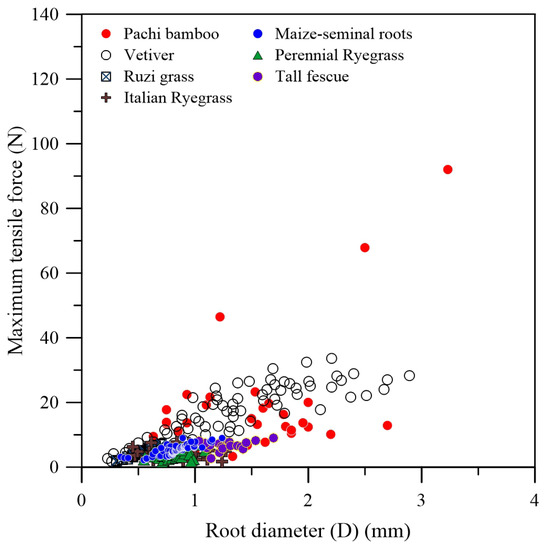
Figure 12.
Comparison of root’s maximum tensile force vs. root diameter relationship between Pachi bamboos and other fibrous root species [48,49,50,51].
4.3. Exploring the Pachi Bamboo in Engineering Practice
Pachi bamboos grow densely in clusters within fields. After several years of growth, a naturally planted bamboo cluster can develop a large number of culms. We investigated the growth characteristics of a single Pachi bamboo cluster planted in 2015 with an initial count of five to six culms. After ten years, this cluster expanded to approximately 550 closely spaced culms. Each culm maintained a consistent diameter of about 20 mm. At ground level, the cluster now spans a diameter of 1.88 m and reaches a height of 4.8 m, with minimal spacing between individual culms. Based on these observations, planting Pachi bamboo clusters—initially containing five to six culms per cluster—at intervals of 2 to 3 m within bamboo clusters on sloped terrain could, over time, develop extensive root systems that significantly reinforce the soil. This characteristic makes Pachi bamboo particularly well-suited for preventing shallow soil failures on slopes.
4.4. Shortcomings and Outlook of the Study
This study presents findings on the root reinforcement characteristics of the Pachi bamboo root system, along with the mechanical properties of its roots. While bamboo is widely distributed globally—particularly throughout Asia—research on the mechanical behavior of bamboo root systems remains limited. In this study, the number of in situ shear and pullout tests conducted on Pachi bamboo roots was constrained by the labor-intensive nature of specimen preparation. Nevertheless, the results provide a practical and straightforward approach for evaluating root reinforcement by Pachi bamboo under field conditions.
The methodologies developed in this study are applicable for assessing soil stability on slopes and along riverbanks where Pachi bamboo is present, underscoring its potential use in engineering applications related to erosion control and slope stabilization. Given that bamboo frequently grows on sloped and rural lands, further research is warranted to investigate the root reinforcement properties of Pachi bamboo at later stages of growth. Such knowledge is essential for the sustainable management of bamboo forests and for maximizing their ecological and engineering benefits.
5. Conclusions
This study examined the reinforcement properties of the Pachi bamboo root system using in situ shear and pullout tests. The relationships between root diameter and both the maximum tensile force and elastic modulus were quantified. Pachi bamboos grow densely in clusters in the field. The root structure of Pachi bamboo is clumping roots, and it grows deeply in the ground, reaching to 1.6 m in four years of growth. The numerous roots of Pachi bamboo make it favorable in protecting against soil failure at shallow depths on slopes.
This study confirmed the hypothesis that the root reinforcement of Pachi bamboo systems is correlated with the characteristics, quantity, and cross-sectional area of bamboo culms in a cluster. Simple formulas were developed to estimate the shear and pullout resistance of Pachi bamboo root systems, based on the characteristics, quantity, and cross-sectional area of bamboo culms within a single cluster. The root system of Pachi bamboo is characterized by its lateral limitations and deep soil penetration, making it potentially effective for reinforcing slopelands.
Moreover, over a 10-year period, the number of culms within a single Pachi bamboo cluster increases significantly, even within a relatively confined area. The root system of Pachi bamboo demonstrates a strong capacity for reinforcing sloped terrain, offering effective stabilization per unit area. These findings support the potential of Pachi bamboo in enhancing soil stabilization and slope stability in engineering practice as well as in bamboo forest management.
Author Contributions
Conceptualization, C.-C.F.; methodology, C.-C.F.; validation, C.-C.F. and C.-H.C.; formal analysis, C.-C.F. and C.-H.C.; investigation, C.-C.F. and C.-H.C.; resources, C.-C.F.; data curation, C.C. and C.-H.C.; writing—original draft preparation, C.-C.F.; writing—review and editing, C.-C.F., C.C., and C.-H.C.; visualization, C.-H.C.; supervision, C.-C.F.; project administration, C.-C.F.; funding acquisition, C.-C.F. All authors have read and agreed to the published version of the manuscript.
Funding
This research was funded by the Taiwan National Science and Technology Council, Taiwan, ROC, grant number MOST 103-2221-E-327-043-MY2.
Data Availability Statement
The data supporting the findings of this research are available upon reasonable request.
Acknowledgments
The authors also would like to thank Jian-Zhi Huang, Ke-Jie Wei, Zhi-Wei Wang, Wen-Quan Xu, Sheng-Fu Lin, and Yen-Wen Chen for their contribution to the fieldwork and data procession.
Conflicts of Interest
Author Chung-Hao Chen was employed by the company CECI Engineering Consultants, Inc., Author Chunhsiung Chen was employed by the company Kuocheng Construction Co. The remaining authors declare that the research was conducted in the absence of any commercial or financial relationships that could be construed as a potential conflict of interest.
References
- Waldron, L.J. The shear resistance of root-permeated homogeneous and stratified soil. Soil Sci. Soc. Am. J. 1977, 41, 843–849. [Google Scholar] [CrossRef]
- Gray, D.H.; Leiser, A.T. Biotechnical Slope Protection and Erosion Control; Van Nostrand Reinhold Co.: New York, NY, USA, 1982; 267p. [Google Scholar]
- Endo, T.; Tsuruta, T. Effects of tree root upon the shearing strengths of soils. Annu. Rep. Hokkaido Branch For. Place Exp. Stn. 1969, 18, 168–179. [Google Scholar]
- Hubble, T.C.T.; Docker, B.B.; Rutherfurd, I.D. The role of riparian trees in maintaining riverbank stability: A review of Australian experience and practice. Ecol. Eng. 2010, 36, 292–304. [Google Scholar] [CrossRef]
- Fan, C.-C.; Chen, Y.-W. The effect of root architecture on the shearing resistance of root-permeated soils. Ecol. Eng. 2010, 36, 813–826. [Google Scholar] [CrossRef]
- Waldron, L.J.; Dakessian, S. Soil reinforcement by roots: Calculation of increased soil shear strength from root properties. Soil Sci. 1981, 132, 427–435. [Google Scholar] [CrossRef]
- Schwarz, M.; Cohen, D.; Or, D. Root-soil mechanical interactions during pullout and failure of root bundles. J. Geophys. Res. 2010, 115, F04035. [Google Scholar] [CrossRef]
- O’Loughlin, C.L. An Investigation of the Stability of the Steepland Forest Soils in the Coast Mountains, Southwest British Columbia. Ph.D. Thesis, University of British Columbia, Vancouver, BC, Canada, 1972. [Google Scholar]
- Greenwood, J.R.; Norris, J.E.; Wint, J. Assessing the contribution of vegetation to slope stability. J. Geotech. Eng. 2004, 157, 199–208. [Google Scholar] [CrossRef]
- Genet, M.; Stokes, A.; Fourcaud, T.; Norris, J.E. The influence of plant diversity on slope stability in a moist evergreen deciduous forest. Ecol. Eng. 2010, 36, 265–275. [Google Scholar] [CrossRef]
- Fan, C.-C.; Lai, Y.-F. Influence of the spatial layout of vegetation on the stability of slopes. Plant Soil 2014, 377, 83–95. [Google Scholar] [CrossRef]
- Mao, Z.; Yang, M.; Bourrier, F.; Fourcaud, T. Evaluation of root reinforcement models using numerical modelling approaches. Plant Soil 2014, 381, 249–270. [Google Scholar] [CrossRef]
- Masi, E.B.; Tofani, V.; Rossi, G.; Cuomo, S.; Wu, W.; Salciarini, D.; Caporali, E.; Catani, F. Effects of roots cohesion on regional distributed slope stability modelling. Catena 2023, 222, 106853. [Google Scholar] [CrossRef]
- Dupuy, L.; Fourcaud, T.; Stokes, A. A numerical investigation into the influence of soil type and root architecture on tree anchorage. Plant Soil 2015, 278, 119–134. [Google Scholar] [CrossRef]
- Reubens, B.; Poesen, J.; Danjon, F.; Geudens, G.; Muys, B. The role of fine and coarse roots in shallow slope stability and soil erosion control with a focus on root system architecture: A review. Trees 2007, 21, 385–402. [Google Scholar] [CrossRef]
- Stokes, A.; Atger, C.; Bengough, A.G.; Fourcaud, T.; Sidle, R.C. Desirable plant root traits for protecting natural and engineered slopes against landslides. Plant Soil 2009, 324, 1–30. [Google Scholar] [CrossRef]
- Ennos, A.R. The anchorage of leek seedlings: The effect of root length and soil strength. Ann. Bot. 1990, 65, 409–416. [Google Scholar] [CrossRef]
- Bischetti, G.B.; De Cesare, G.; Mickovski, S.B.; Rauch, H.P.; Schwarz, M.; Stangl, R. Design and temporal issues in soil bioengineering structures for the stabilisation of shallow soil movements. Ecol. Eng. 2021, 169, 106309. [Google Scholar] [CrossRef]
- Zhou, B.; Fu, M.; Xie, J.; Yang, X.; Li, Z. Ecological functions of bamboo forest: Research and Application. J. For. Res. 2005, 16, 143–147. [Google Scholar]
- Mishra, G.; Giri, K.; Panday, S.; Kumar, R.; Bisht, N.S. Bamboo: Potential resource for eco-restoration of degraded lands. J. Biol. Earth Sci. 2014, 4, B130–B136. [Google Scholar]
- Tardio, G.; Mickovski, S.B.; Rauch, H.P.; Fernandes, J.P.; Acharya, M.S. The use of bamboo for erosion control and slope stabilization: Soil bioengineering works. In Bamboo: Current and Future Prospects; IntechOpen: London, UK, 2018; p. 105. [Google Scholar]
- Hairiah, K.; Widianto, W.; Suprayogo, D.; Van Noordwijk, M. Tree roots anchoring and binding soil: Reducing landslide risk in Indonesian agroforestry. Land 2020, 9, 256. [Google Scholar] [CrossRef]
- Lin, D.-G.; Liu, W.-T.; Lin, S.-H. Estimating the Effect of Shear Strength increment due to root on the stability of Makino bamboo forest slopeland. J. Geoeng. 2011, 6, 73–88. [Google Scholar]
- Wang, X.; Keplinger, T.; Gierlinger, N.; Burgert, I. Plant material features responsible for bamboo’s excellent mechanical performance: A comparison of tensile properties of bamboo and spruce at the tissue, fibre, and cell wall levels. Ann. Bot. 2014, 8, 1627–1635. [Google Scholar] [CrossRef] [PubMed]
- Li, Z.; Chen, C.; Mi, R.; Gan, W.; Hu, L. A strong, tough, and scalable structural material from fast-rowing bamboo. Adv. Mater. 2020, 32, 1906308. [Google Scholar] [CrossRef] [PubMed]
- Wang, Y.Y.; Wang, X.Q.; Li, Y.Q.; Huang, P.; Fu, S.Y. High-performance bamboo steel derived from natural bamboo. ACS Appl. Mater. Interfaces 2020, 13, 1431–1440. [Google Scholar] [CrossRef] [PubMed]
- Gao, X.; Zhu, D.; Fan, S.; Rahman, M.Z.; Guo, S.; Chen, F. A review of the structural and mechanical properties of bamboo fiber bundle and fiber/bundle reinforced composites. J. Mater. Res. Technol. 2022, 19, 1162–1190. [Google Scholar] [CrossRef]
- Zong, Y.; Chen, X.; Luo, X.; Su, Q.; Zhang, X.; Yan, Y.; Liu, H. Effect of Bamboo Culm Grading on the Properties of Flattened Bamboo Boards. Forests 2023, 14, 1120. [Google Scholar] [CrossRef]
- Rana, A.K.; Mandal, A.; Bandyopadhyay, S. Short jute fiber reinforced polypropylene composites: Effect of compatibiliser, impact modifier and fiber loading. Compos. Sci. Technol. 2003, 63, 801–806. [Google Scholar] [CrossRef]
- Shah, D.U. Developing plant fibre composites for structural applications by optimising composite parameters: A critical review. J. Mater. Sci. 2013, 48, 6083–6107. [Google Scholar] [CrossRef]
- Perremans, D.; Trujillo, E.; Ivens, J.; Van Vuure, A.W. Effect of discontinuities in bamboo fibre reinforced epoxy composites. Compos. Sci. Technol. 2018, 155, 50–57. [Google Scholar] [CrossRef]
- Ahmad, Z.; Upadhyay, A.; Ding, Y.; Emamverdian, A.; Shahzad, A. Bamboo: Origin, habitat, distributions and global perspective. In Biotechnological Advances in Bamboo; Ahmad, Z., Ding, Y., Shahzad, A., Eds.; Springer: Singapore, 2021. [Google Scholar] [CrossRef]
- Chen, C. Herbarium of Taiwan Forestry Research Institute. Version 1.8. Taiwan Forestry Research Institute. Occurrence Dataset 2021. Available online: https://www.gbif.org/occurrence/1821909071 (accessed on 5 March 2024).
- POWO Plants of the World Online. Facilitated by the Royal Botanic Gardens, Kew. Published on the Internet. 2024. Available online: https://powo.science.kew.org/taxon/urn:lsid:ipni.org:names:392450-1 (accessed on 16 July 2024).
- Canadell, J.; Jackson, R.B.; Ehleringer, J.R.; Mooney, H.A.; Sala, O.E.; Schulze, E.D. Maximum rooting depth of vegetation types at the global scale. Oecologia 1996, 108, 583–595. [Google Scholar] [CrossRef]
- Loades, K.W.; Bengough, A.G.; Bransby, M.F.; Hallett, P.D. Planting density influence on fibrous root reinforcement of soils. Ecol. Eng. 2010, 36, 276–284. [Google Scholar] [CrossRef]
- Cohen, D.; Schwarz, M. Tree-root control of shallow landslides. Earth Surf. Dynam. 2017, 5, 451–477. [Google Scholar] [CrossRef]
- Cislaghi, A.; Cohen, D.; Gasser, E.; Bischetti, G.B.; Schwarz, M. Field measurements of passive earth forces in steep, shallow, landslide-prone areas. J. Geophys. Res. Earth Surf. 2019, 124, 838–866. [Google Scholar] [CrossRef]
- Giadrossich, F.; Schwarz, M.; Cohen, D.; Cislaghi, A.; Vergani, C.; Hubble, T.; Phillips, C.; Stokes, A. Methods to measure the mechanical behaviour of tree roots: A review. Ecol. Eng. 2017, 109, 256–271. [Google Scholar] [CrossRef]
- Phillips, C.J.; Marden, M.; Lambie, S.; Watson, A.; Ross, C.; Fraser, S. Observations of below-ground characteristics of young redwood trees (Sequoia sempervirens) from two sites in New Zealand—Implications for erosion control. Plant Soil 2013, 363, 33–48. [Google Scholar] [CrossRef]
- Wu, T.H.; McKinell, W.P.; Swanston, D.N. Strength of tree roots and landslides on Prince of Wales Island, Alaska. Can. Geotech. J. 1979, 16, 19–33. [Google Scholar] [CrossRef]
- Deljouei, A.; Cislaghi, A.; Abdi, E.; Borz, S.A.; Majnounian, B.; Hales, T.C. Implications of hornbeam and beech root systems on slope stability: From field and laboratory measurements to modelling methods. Plant Soil 2023, 483, 547–572. [Google Scholar] [CrossRef]
- Vergani, C.; Chiaradia, E.A.; Bischetti, G.B. Variability in the tensile resistance of roots in Alpine forest tree species. Ecol. Eng. 2012, 46, 43–56. [Google Scholar] [CrossRef]
- Topp, C.N.; Benfey, P.N. Growth control of root architecture. In Plant Biotechnology and Agriculture; Altman, A., Hasegawa, P.M., Eds.; Prospects for the 21st Century; Academic Press: Amsterdam, The Netherlands, 2012. [Google Scholar] [CrossRef]
- Ma’ruf, M.F. Shear strength of Apus bamboo root reinforced soil. Ecol. Eng. 2012, 41, 84–86. [Google Scholar] [CrossRef]
- Mulyanti, J.; Hendra, D.; Megaprastio, B. Utilization of Bamboo Roots as Reinforcing Composite Materials for Light Vehicle Dashboards. J. Phys. 2024, 2739, 012031. [Google Scholar] [CrossRef]
- Cislaghi, A. Exploring the variability in elastic properties of roots in Alpine tree species. J. For. Sci. 2021, 67, 338–356. [Google Scholar] [CrossRef]
- Chimungu, J.G.; Loades, K.W.; Lynch, J.P. Root anatomical phenes predict root penetration ability and biomechanical properties in maize (Zea mays). J. Exp. Bot. 2015, 66, 3151–3162. [Google Scholar] [CrossRef] [PubMed]
- Teerawattanasuk, C.; Maneecharoen, J.; Bergado, D.T.; Voottipruex, P.; Le, G.L. Root strength measurements of Vetiver and Ruzi grasses. Lowl. Technol. Int. 2014, 16, 71–80. [Google Scholar] [CrossRef] [PubMed]
- Boldrin, D.; Bengough, A.G.; Lin, Z.; Loades, K.W. Root age influences failure location in grass species during mechanical testing. Plant Soil 2021, 461, 457–469. [Google Scholar] [CrossRef]
- Ekeoma, E.C.; Boldrin, D.; Loades, K.W.; Bengough, A.G. Drying of fibrous roots strengthens the negative power relation between biomechanical properties and diameter. Plant Soil 2021, 469, 321–334. [Google Scholar] [CrossRef]
Disclaimer/Publisher’s Note: The statements, opinions and data contained in all publications are solely those of the individual author(s) and contributor(s) and not of MDPI and/or the editor(s). MDPI and/or the editor(s) disclaim responsibility for any injury to people or property resulting from any ideas, methods, instructions or products referred to in the content. |
© 2025 by the authors. Licensee MDPI, Basel, Switzerland. This article is an open access article distributed under the terms and conditions of the Creative Commons Attribution (CC BY) license (https://creativecommons.org/licenses/by/4.0/).